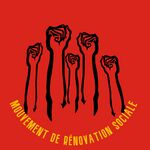Social Renovation Movement
| Mouvement De Rénovation Sociale | |
 | |
| Abbreviation | SRM |
|---|---|
| Formation | c. 1910 |
| Founder | Xavier Marois Leon Barbeau |
| Founded at | Chantiers, Chantier, Aciria |
| Type | Revolutionary Organisation |
| Purpose |
|
Official language | Acirien |
Key people | Xavier Marois, Mikael Letendre |
The Social Renovation Movement (SRM; Acirien: Mouvement De Rénovation Sociale) is a revolutionary Marxist organisation in Aciria.
Founded around 1910 in Chantiers initially, founder Xavier Marois intended for the SRM to push Marxist ideals in both the People's Senate and the Imperial Senate to encourage social reform to reduce poverty and economic differences in the nation. Later, Mikael Letendre turned the organisation from its original peaceful organisation to the revolutionary organisation it's known as today. Starting in 1910, Marois and Barbeau used their personal funds to print Marxist leaflets and spread them in Chantiers. The effort was successful, quickly bringing more members into the SRM, who then were tasked with handing out these leaflets in other cities, such as Trosseurs and Soleir. Chantiers being a port city, the fast growing organization was able to spread their word across the nation because of the sailors that spread their leaflets wherever their ship landed. The recently constructed, and still being constructed, Imperial Railway, also employed many SRM members. Declassified PAI reports indicate PAI had already infiltrated the SRM in its early days, causing discussion regarding PAI's influence on the politics of early SRM.
By 1935 the organisation had grown so large the government started fearing the radicalisation of their elements, starting a widespread propaganda campaign against the SRM and Marxism, often reminding the populace of the stability which the Emperor had brought to Aciria in 1783. Despite smaller marches in Chantiers and Soleir, the most notable march of the SRM was in 1935 in Trosseurs, lead by Marois himself. Marois met an untimely death in the middle of the march as then 23-year old Lucas Lajoie ran from an alleyway armed with a pistol, and shot Marois in the heart. Lajoie was quickly rescued from the SRM members by the riot police which were overseeing the march, and Marois was pronounced dead at the Imperial Hospital of Trosseurs. Following the assassination of Marois, a widely publicized court case against Lajoie was held. Two months after Marois' death, Lajoie was found not guilty on account of insanity, and was placed in an undisclosed asylum. This sparked outrage in the SRM, which was quickly becoming too much for Barbeau to handle.
In 1936, SRM was about to fragment into smaller, less influential Marxist groups as Barbeau was unable to calm down the radical elements of the movement, outraged by the lack of action against the government regarding Lajoie's sentence. Mikael Letendre, a 46-year old sailor from Trosseurs managed to grab the attention of SRM with this charismatic, revolutionary speeches; he ousted Barbeau from the position of power he once was in, becoming the de facto leader of SRM. Some were alienated by his revolutionary ideology, and some were converted, believing revolution was the only way to bring equality to the nation due to the corruption of the Emperor. On December 7th, 1936, the movement was criminalized after a terror attack on the courthouse where Lajoie's sentence was carried out and Letendre refused to denounce the act, solidifying the revolutionary nature of the organisation.